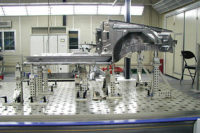In conventional 3D scanning measurement methods the CMM performs all the movements necessary to acquire the surface data. Acceleration forces induce inertia deflections into the CMM 3d scanning frame structure, which in turn induce measurement errors.
Metrology equipment system manufacturers have devoted years to develop techniques that reduce these dynamic errors, but there is an upper speed limit imposed by the machine and servo system stiffness, beyond which measurement cannot be taken with reliability. A stiff CMM frame is critical for effective scanning which is why aluminum frame CMMs make for a poor scanning solution and all-granite CMMs are the stiffest available.
Renscan5 breaks through this limit by using a continuous motion articulating head that moves simultaneously in two rotary axes as it scans. This technique allows the CMM to do what it is best designed to do - move at constant velocity in along a single vector while measuring. As the head is much lighter and more dynamic than the CMM it's able to quickly follow changes in the part geometry without introducing harmful CMM dynamic errors. This results in much faster surface 3D scanning speeds and hence much shorter measurement cycles. 5-axis scanning technology allows the user to achieve unprecedented levels of throughput while maintaining current levels of metrology uncertainties.

